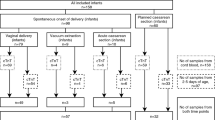Abstract
We measured serial cardiac troponin T in babies with respiratory distress syndrome and in “healthy” controls (no cardiorespiratory support required). We investigated relationships between cardiac troponin T and myocardial performance in respiratory distress syndrome. This was a prospective observational study at a large tertiary maternity unit that recruited 104 “healthy” babies from whom individual samples were collected. A further 24 infants with respiratory distress syndrome and 14 “healthy” preterm infants had serial sampling over the first three days. We measured fractional shortening in 14 of the infants with respiratory distress syndrome. Cardiac troponin T rose from a median (interquartile range) of 10 (10–11) pg/mL on day one to 34 (22–46) pg/mL by day three, p=0.005, in “healthy” babies. In respiratory distress syndrome levels were higher, 91 (46–135) pg/mL at 6 (5–7) hours of age, p<0.001, and remained so for all three days. In babies with respiratory distress syndrome on day one cardiac troponin T correlated negatively with fractional shortening, Rho=−0.831, p<0.001, but this correlation did not persist. In “healthy” babies there is a minimal rise of cardiac troponin T by day 3. In respiratory distress syndrome there is an early and sustained elevation of cardiac troponin T, with a negative relationship with fraction shortening, suggesting significant myocardial damage of antenatal/intrapartum origin, giving rise to measurable dysfunction.


Similar content being viewed by others
References
Anon (1999) Troponin T STAT data sheet. Roche Diagnostics GmbH, Mannheim, Germany
Aviles RJ, Askari AT, Lindahl B, Wallentin L, Jia G, Ohman EM (2002) Troponin T levels in patients with acute coronary syndromes, with or without renal dysfunction. N Engl J Med 346:2047–2052
Bhayana V, Henderson AR (1995) Biochemical markers of myocardial damage. Clin Biochem 28:1–29
Bodor GS, Survant L, Voss EM (1997) Cardiac troponin T composition in normal and regenerating human skeletal muscle. Clin Chem 43:476–484
Clark SJ, Newland P, Yoxall CW, Subhedar NV (2000) Cardiac troponin T in cord blood. Arch Dis Child 84:F34–F37
Clark SJ, Newland P, Yoxall CW, Subhedar NV (2004) Neonatal levels of cardiac troponin T with and without respiratory distress. Arch Dis Child 89:F348–F352
Clark SJ, Yoxall CW, Subhedar NV (2002) Right ventricular volume measurements in healthy term and healthy preterm neonates. Arch Dis Child 87:F89–F93
Cunningham S, Symon AG, Elton RA (1999) Intra-arterial blood pressure reference ranges, death and morbidity in very low birthweight infants during the first seven days of life. Early Hum Dev 56:151–165
Evans N, Kluckow M (1996) Early determinants of right and left ventricular output in ventilated preterm infants. Arch Dis Child 74:F88–F94
Finley JP, Howman-Giles RB, Gilday DL (1979) Transient myocardial ischaemia of the newborn demonstrated by thallium myocardial imaging. J Pediatr 94:263–270
Gardner DS, Fowden AL, Giussani DA (2002) Adverse intrauterine conditions diminish the fetal defense against acute hypoxia by increasing nitric oxide activity. Circulation 106:2278–2283
Gessner I, Krovetz J, Benson RW (1965) Hemodynamic adaptations in the newborn infant. Pediatrics 36:752–762
Gill AB, Weindling AM (1993) Echocardiographic assessment of cardiac function in shocked very low birthweight infants. Arch Dis Child 68:17–21
Harada K, Shiota T, Takahashi Y (1994) Doppler echocardiographic evaluation of left ventricular output and left ventricular diastolic filling changes in the first day of life. Pediatr Res 35:506–509
Henry WL, De Maria A, Gramiak R (1980) Report of the American Society of Echocardiography Committee on nomeculture and standards in 2 dimensional echocardiography. Circulation 62:212–217
Hudson I, Houston A, Aitchison T, Holland B, Turner T (1990) Reproducibility of measurements of cardiac output in newborn infants by Doppler ultrasound. Arch Dis Child 65:15–19
Moller J, Thielsen B, Schaible TF, Reiss I, Kohl M, Welp T, Gortner L (1998) Value of myocardial hypoxia markers (creatine kinase and its MB fraction, troponin T, QT intervals) and serum creatinine for the retrospective diagnosis of perinatal asphyxia. Biol Neonate 73:367–374
Panteghini M (2002) Acute coronary syndrome: biochemical strategies in the troponin era. Chest 122:1428–1435
Primhak RA, Jedeikin R, Ellis G (1985) Myocardial ischaemia in asphyxia neonatorum. Acta Paediatr Scand 74:595–600
Remppis A, Scheffold T, Greten J (1995) Intracellular compartmentation of troponin T: release kinetics after global ischaemia and calcium paradox in the isolated perfused rat heart. J Moll Cell Cardiol 27:793–803
Sasse S, Brand NJ, Kyprianou P (1993) Troponin I gene expression during human cardiac development and in end-stage heart failure. Circ Res 72:932–938
Smolich JJ, Berger PJ, Walker AM (1996) Interrelation between ventricular function, myocardial blood flow and oxygen consumption at birth in lambs. Am J Physiol 270:H741–H749
Trevisanuto D, Zaninotto M, Altinier S, Plebani M, Zanardo V (2000) High serum cardiac troponin T concentrations in preterm infants with respiratory distress syndrome. Acta Paediatr 89:1134–1136
Trevisanuto D, Zaninotto M, Lachin M, Altinier S, Plebani M, Ferrarese P, Zanardo V (2000) Effect of patent ductus arteriosus and indomethacin treatment on serum cardiac troponin T levels in preterm infants with respiratory distress syndrome. Eur J Pediatr 159:273–276
Walther FJ, Siassi B, Ramadan NA (1985) Cardiac output in newborn infants with transient myocardial dysfunction. J Pediatr 107:781–785
Watkins AM, West CR, Cooke RW (1989) Blood pressure and cerebral haemorrhage and ischaemia in very low birth weight infants. Early Hum Dev 19:103–110
Author information
Authors and Affiliations
Corresponding author
Additional information
This work was carried out at Liverpool Women's Hospital & Royal Liverpool Children's NHS Trust
Funding for this study came from The Newborn Appeal, a charity associated with Liverpool Women's Hospital
Rights and permissions
About this article
Cite this article
Clark, S.J., Newland, P., Yoxall, C.W. et al. Sequential cardiac troponin T following delivery and its relationship with myocardial performance in neonates with respiratory distress syndrome. Eur J Pediatr 165, 87–93 (2006). https://doi.org/10.1007/s00431-005-0001-3
Received:
Accepted:
Published:
Issue Date:
DOI: https://doi.org/10.1007/s00431-005-0001-3




